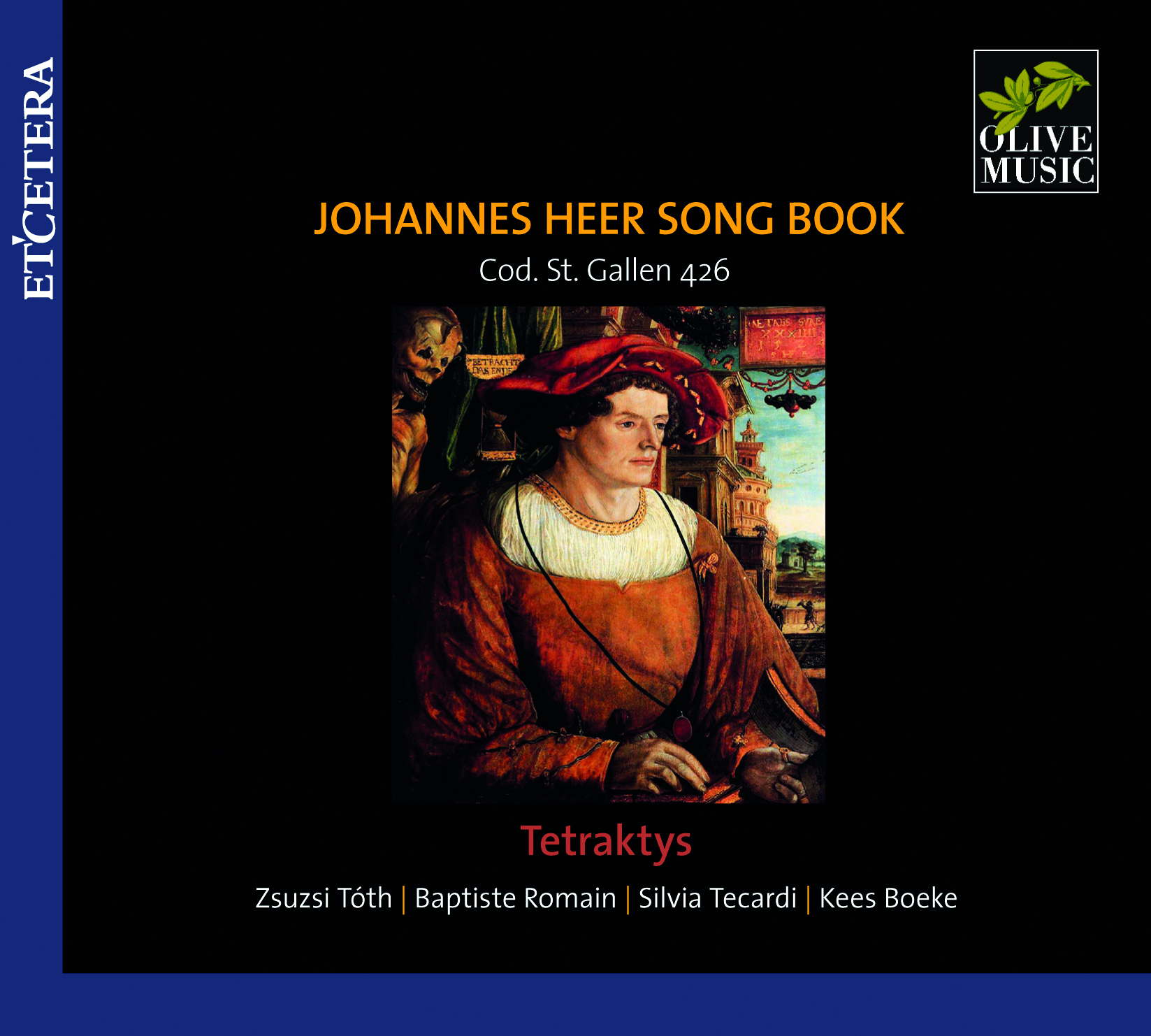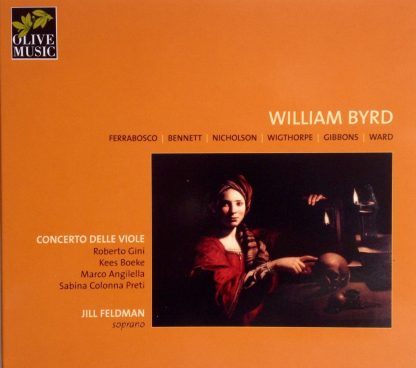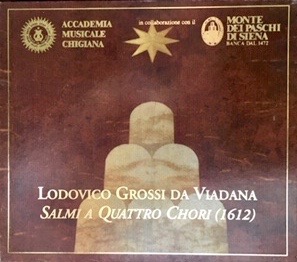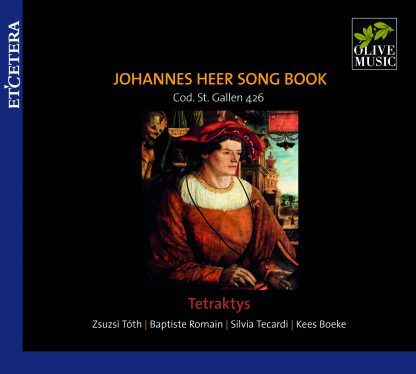Description
Tetraktys: “Johannes Heer Song Book”
The songbook of Johannes Heer from Glarus is one of the most important testimonies to the bourgeois musical culture of the early 16th Century in Switzerland and constitutes a key piece of the music collection of the Abbey Library of St. Gallen. Due to the international repertoire gathered in it, it is however, besides its regional importance, also an excellent document for the cross border musical culture of the European Renaissance. The program compiled on this CD with 3 – and 4-part songs and instrumental pieces offers a representative selection from the repertoire of the manuscript, which thus comes alive in terms of its original context: what music did Johannes Heer make and listen to, which music could a learned but provincial cleric know shortly after 1500?
The owner
Johannes Heer (1489-1553) was born in Glarus and was a choirboy at Sitten, so that he would have received his first musical training as part of his preparation for a religious career and thus the musical knowledge necessary for the liturgy. His interest in music would however gain still greater importance: During his studies in Paris, where he enrolled in 1508, he began to create his music collection, as is proven by an entry in his song book dated 1510 : “Je suys au maistre Jehan Her de glaris.” After his return to Glarus in 1512, he worked there until the end of his life as a clergyman. Although he converted to the Reformation in 1529, and married, he remained rather moderate, and still remained in contact with both the Zurich reformer Huldrych Zwingli (1484-1531) and with the Catholic politician, scholar and historian Aegidius Tschudi (1505-1572). And of course he also knew one of the other important Glarus humanists of his generation, Heinrich Glarean (1488-1563), who taught from 1529 at the University of Freiburg im Breisgau. In other words, Heer found himself in an environment very open-minded towards humanism and sent his son Jörg to Zurich to study with Johannes Fries, in order to get him a thorough education as well. Although he probably could not continue his activity as a music collector after returning to Glarus with the same zeal as in his youth, it is at least known that he long remained active in the execution of liturgical chant.
The source : Sang Cod . 462
Johannes Heer’s songbook represents a source type that documents the enormous diversity and the international exchange of repertoire in the 16th Century. Like Heer, many music lovers – who were even in personal contact among each other in some cases – started manuscript collections in which they brought together all sort of pieces for their own use: there are musical settings of Latin, German, French and Italian texts, but also instrumental works side by side. These collections often emerged during the study period of their owners, so that they convey at the same time an idea of what making music may have been in the university cities in student circles. They were also important enough for owners that were not professionally active in music to be kept in their libraries and supplemented decades later, possibly repeatedly, because they appreciated music as an essential part of general education, recreation and socializing.
[ ILL 1 page with additional text ]
The designation “Songbook “ still does not give a complete picture of the characteristics of Heer’s music collection: In addition to the songs and lyrics, on numerous pages other short texts (proverbs and maxims , literary quotes and bible passages ) are entered by Heer himself , but also by several other hands . The manuscript may have circulated at the same time as a collective book between him and his friends, who documented their acquaintance with the entries. Therefore verses of Glarean can be found in the book, but also quotations from the works of ancient authors and contemporary humanists, which produce a florilegium of maxims and platitudes. Even if the major portion was compiled in 1510, Heer still later added some vocal pieces , including in 1530 Was will de doch by probably the most successful Swiss composer at the time, Ludwig Senfl . Heers collection also had a not uninteresting afterlife: Aegidius Tschudi based the compilation of his own songbook (Cod Sang 463 ) partially on Heer’s manuscript and even acquired this after Heer’s death for his own library.
The repertoire
The pieces in Heer’s collection show how international the repertoire was that circulated among the music lovers of the early 16th Century. The various linguistic areas of origin developed different song forms: In German, the “Tenorlied” reigns, in which the melody lies in the tenor part, while the accompanying voices could be more or less closely related to it. The French chanson was oriented towards other poetic forms such as the Rondeau and treated the upper voice as the main melody. Regardless of the language however, chansons were sung throughout Europe, since musicians from the Franco-Flemish regions worked in many places in Central and Southern Europe. The Italian compositions reveal a third, also melody-oriented, but more chordal style, in which the upper voice carries the melody. Heer was well aware of these differences in the repertoire, since he grouped his material in large sections by language and content: At the beginning of his collection there are the compositions with Latin spiritual texts, followed by German songs, French chanson, and finally a few Italian pieces. About the first two thirds of the collection form a closed inventory after which a second section follows, again with sacred Latin compositions. In some cases, Heer’s versions are the oldest known transmitted to us; but also a remarkable number of pieces, almost half, are exclusively known from his manuscript, so that it represents a particularly valuable testimony.
The pieces on this CD
O werder mund was originally a Flemish song, which circulated with a German Text imitation, and its popularity is documented by numerous vocal and instrumental versions. In addition to the mouth of the beloved mentioned in the title, other body parts such as hair and eyes are put into song and praised in the verses. The melody is in the alto, while the other voices remain relatively homophonic. Erhoer mich Lieb is a German text with a certain humanistic impact: the speaker, in wooing his beloved, appeals to Homer’s praise of Helen (to then naturally prefer his lover), and to the history of Harmonia, the daughter of the King of Syracuse, who sacrificed herself out of magnanimity. Ein froelich wesen is essentially an alternative setting of a known Flemish song, which, in a version attributable to Jacob Barbireau (although most probably erroneously under the name Obrecht), is also included in Heer’s book with an added alto part. Since Heer drew his family coat of arms at the end of the three-part version and called it “A nüwes frölich wesen”, it is conceivable that he himself has written his own version of this popular song.
[ILL this page?]
Ach Hulf also shows the multiple transmission traditions in the field of song repertoire – Heer included a total of 4 versions of the song in his book, including that of Adam of Fulda († 1505), which was particularly widespread in the German lands, according to Glarean. However, the three-part version played on this recording is by an unknown composer – it sets the given melody in the upper voice, while one of the two lower voices each time pre-imitate its entry, and also the tenor and bass lines between them are again and again linked by smaller motifs. Finally, Zum nüwen Jar is a parody of contemporary New Year songs whose jocular text is enhanced in effect by the punning repetitions. For Heer’s version of On Freud, a lover’s complaint, likewise no composer is known. However, also this song must have been popular enough that it is still preserved in at least one other version. Moreover, the Catholic polemicist Thomas Murner named this melody in his criticism that hymns were sung to well-known secular tunes. Of Von tugend milt no other source is known; here the reverence for the beloved turns into disappointment and the lover who has learned his lesson breaks into an angry call to revenge.
With Alles regrets, which Heer copies anonymously as well, and quoting only the first text words, we are presented with a composer especially famous and important for his chansons at the turn of the 15th to 16th century, Loyset Compère († 1518).
However, the song actually bears the text Venez regrets which Heer may have confused by mistake – which is not implausible, since there was a whole network of songs of various composers on the theme “regrets” all associated to each other via textual references. Pour vos plaisirs , on the other hand, is a chanson with a slightly more lascivious text: The girls are there for the pleasure of the gentlemen , especially when one is alone with them. It is probably to be ascribed to Alexander Agricola († 1506) who is also the author of two of the instrumental pieces. After a homophonic beginning entries between multiple voices are heard typical of the earlier imitative chanson; and the “pleasure” enjoyed in seclusion evoked in the text, may possibly have triggered the most lively rhythmical close imitations at the end of verse. Cum audisset Job is one of only two known works by Rigo de Bergis, who we might identify as a singer and clergyman living around 1500 in Bergen op Zoom. It is a motet that develops long lines on a distinctive ostinato motif in the bass, from which the upper voices are partly derived. La gran pena ch’io sento finally adds the musical language that so far is still missing here, Italian. Here it is shown in the typical form of the frottola which is predominantly chordal, but in contrast to the contemporary German songs it has an underlying melody in the upper voice that gives it a very song-like aspect and closely follows the poetical forms.
Some pieces are not only transmitted without text in the sources, but they also differ in their compositional technique from genuine vocal compositions, so that they might have been intended from the outset to be played with instruments: they are relatively long and therefore require a variety of compositional techniques that are applied in sections. These include Der Hund (about the real meaning of this title we can only speculate) by Heinrich Isaac († 1517), who worked mainly in Florence and at the court of Emperor Maximilian I. Here we find , next to short imitations, also more extensive passages in which on a leading, slower voice small sequenced motifs are repeated on different levels, so that a suggestive musical dynamic arises, as it is not found in the chansons and songs. Two other instrumental pieces originate from the aforementioned Alexander Agricola, at the time a highly famous composer in Europe: originally from the Southern Netherlands, he worked in France and Italy, in Cambrai, Florence and Naples, as a singer and viola player. His composition with the significant Latin title “Caecus non iudicat de coloribus” (“ The blind should not judge about color “) is also an example of instrumental idiomatic writing: there are numerous small phrases, repetition and rhythmic gimmicks that enliven the piece. Next to that, there are surprisingly many longer scale fragments that serve as a structural frame for musical development. The piece called Cantilena iucundissima however is probably originally vocal, but since it has been handed down without any reference to a text or author (only Aegidius Tschudi copied it), it is also performed here instrumentally.
Inga May Groote





Reviews
There are no reviews yet.